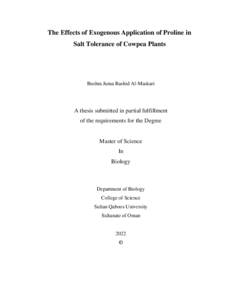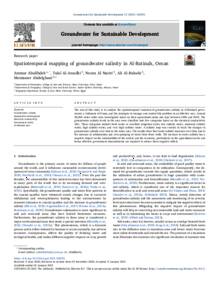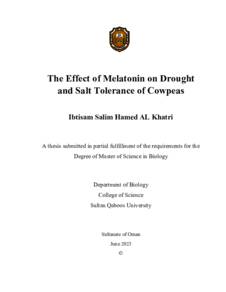Document
The Effects of exogenous application of proline in salt tolerance of cowpea plants.
Other titles
آثار التطبيق الخارجي للبرولين في تحمل الملوحة لنبات اللوبيا
Publisher
Sultan Qaboos University.
Gregorian
2022
Language
English
English abstract
Salinity is a significant threat to crop production in Oman and worldwide. Salt stress
severely reduces plant productivity and yields. In Oman, the amount of cultivated land
that is exposed to salinity is about 50%. Therefore, developing effective strategies for
surviving with salinity and increasing plant's tolerance to salt stress is essential. The
cowpea plant is considered an important grain legume because of its great nutritional
value and ability to adapt to environmental stress like salinity. However, the cowpea
loses its ability to grow and develop at a high salinity level. Proline is an amino acid
that helps different crops tolerate salt and minimize the damage caused by salinity.
Therefore, this study focuses on understanding proline's effect on cowpea plants
exposed to salinity. The cowpea seeds were planted on soil and irrigated with different
concentrations of NaCl (0, 40, 80, 100, and 150 mM) and proline solutions (0, 10, 20,
30, 60, and 80 mM) to evaluate the positive effect of proline on different levels of
salinity by measuring changes in various plant's growth parameters. These
measurements include plant height, leaf area, chlorophyll pigments, root system
photosynthetic efficiency, and antioxidant defense integrity.
Salinity negatively affects different morphological and photosynthetic parameters,
such as the root system, chlorophyll pigments, and photosynthetic efficiency. In
addition, it reduces a plant cell's capacity to absorb water and minerals and leads to
ROS accumulation in cowpeas. However, the use of proline positively affected
different morphological and photosynthetic parameters when the plants grew under
control and saline conditions. For example, proline enhanced leaf area, plant height,
chlorophyll pigments, photosynthetic efficiency, and antioxidant defense system.
Additionally, proline showed a positive effect on the TPC, TFC, and glutathione when
grown under saline conditions.
Overall, the results showed that the cowpea plants treated with proline at a
concentration of 30 mM were more tolerant to salt stress than the control. Furthermore,
the results showed that cowpea plants had evolved effective antioxidant defense
enzymes, including SOD, CAT, and APX to control oxidative damage under salt stress
and proline conditions. This study is looking for a radical solution to the soil salinity
issue and the role of proline in solving this problem to develop crops in Oman and the
world.
Member of
Resource URL
Arabic abstract
تشكل ملوحة التربة خطرا كبيرا على إنتاج المحاصيل الزراعية في سلطنة عمان وفي جميع أنحاء العالم. حيث أن الاجهاد الملحي يقلل بشدة من إنتاجية المحاصيل الزراعية. تبلغ مساحة الاراضي المزروعة والمعرضة للملوحة في سلطنة عمان حوالي .٪50 لذلك كان من الضروري عمل وتطوير استراتيجيات فعالة تساهم وتساعد النباتات في التعايش و تحمل هذا الاجهاد الملحي. يعد نبات اللوبيا من البقوليات المهمة وذلك بسبب قيمته الغذائية الكبيرة ، كما أن لنبات اللوبيا قدرة عالية في التكيف مع الضغوط البيئية مثل لملوحة التربة. ولكن في حالات الملوحة الشديدة جدا ، يفقد نبات اللوبيا قدرته على النمو والتطور بشكل سليم. نشرت بعض الدراسات السابقة ، أن البرولين هو حمض أميني يساعد المحاصيل الزراعية المختلفة على تحمل الاجهاد الملحي ، وأثبتت بعض الفرضيات أن البرولين يساهم في تقليص الاضرار التي تسببها الملوحة. حيث أنه ضروري للتحكم في نمو النباتات وتطورها وتنظيمها تحت الضغوط البيئية. يهدف هذا البحث إلى دراسة تأثير البرولين على نبات اللوبيا المعرض للملوحة. زرعت بذور اللوبيا في تربة خاصة ، وتم ريها بتركيزات مختلفة من كلوريد الصوديوم (NaCl (0, mM 150 100, 80, , 40 وكذلك البرولين mM 80 60, 30, 20, 10, 0, لتحديد التركيز المناسب من NaCl لتعريض نبات اللوبيا للملوحة والتركيز المناسب من البرولين لمعالجة النبات. بعد ذلك ، تمت دراسة خصائص نمو النباتلأربع مجموعات )المجموعة الضابطة ، NaCl mM 150 ، mM 30 برولين ، و 150 NaCl mM + mM 30 برولين(. علاوة على ذلك ، تم دراسة تأثير البرولين من خالل قياس كفاءة التمثيل الضوئي و مضادات الاكسدة لشتلات اللوبيا المعرضة للملوحة. أظهرت النتائج أن نباتات اللوبيا المعالجة بالبرولين بتركيز mM 30 قادرة على تحمل الاجهاد المحلي. كما أوضحت النتائج أن الملوحة تسبب تأخير في نمو النبات بسبب ضعف الجذور كما يقل تركيز أصباغ الكلوروفيل ومعايير كفاءة التمثيل الضوئي. وتؤدي الملوحة أيضا إلى صعوبة امتصاص الماء و المعادن في الخلايا النباتية وزيادة تراكم ROS. كما أظهرت النتائج أن نباتات اللوبيا قد طورت إنزيمات دفاعية فعالة مضادة للأكسدة بما في ذلك SOD و CAT و APX للسيطرة على الضرر التأكسدي تحت ضغط الملح وعند معالجة النباتات بالبرولين. كما أدى التطبيق الخارجي للبرولين تحت تأثير الملوحة إلى زيادة TPC. تبحث هذه الدراسة عن حل جذري لمشكلة ملوحة التربة ودور البرولين في حل هذه المشكلة من أجل تنمية المحاصيل الزراعية في عمان والعالم.
Category
Theses and Dissertations



